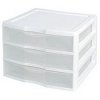Hello guys.
I have just started learning electronics. Now I have many components (breadboards, jumper wires, micro-controllers, resistors, capacitors, transistors, lcd, LEDs, ICs, etc).
I keep most of my components (eg. resistors, capacitors, and transistors) in plastic bags. I store all my components in a drawer.
I would like to know from you what is the best way to organize electronic components. Are they any tools to store them (that I can get from Digi-key, for example)?
I have just started learning electronics. Now I have many components (breadboards, jumper wires, micro-controllers, resistors, capacitors, transistors, lcd, LEDs, ICs, etc).
I keep most of my components (eg. resistors, capacitors, and transistors) in plastic bags. I store all my components in a drawer.
I would like to know from you what is the best way to organize electronic components. Are they any tools to store them (that I can get from Digi-key, for example)?











